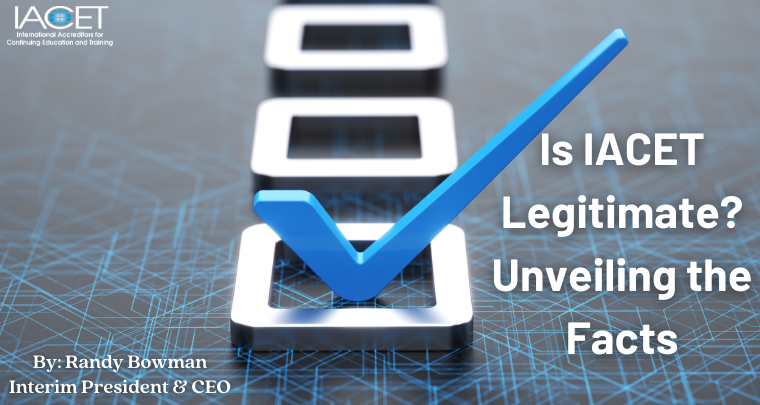Is IACET Legitimate? Unveiling the Facts

I was recently in a conversation with one of our Accredited Providers who sheepishly confessed when he was first seeking accreditation, he was leery of the International Accreditors for Continuing Education and Training (IACET) organization because he had never heard about it.
It didn’t help that the second suggestion from everybody’s favorite search engine was “is IACET legitimate.” WOW!
Luckily, this individual persisted, continued to do his research, and eventually his training program was awarded accreditation. He is now one of the most outspoken supporters of IACET and often talks about how seeking accreditation raised his company to a whole other level of quality that he didn’t know existed.
It made me stop and wonder how many other people experience the same apprehensions when starting their accreditation journey and let those stones of suspicion become an obstacle that prevents them from becoming the training provider they were meant to be. It is my hope that a few facts will help quell their doubts and silence that small voice of skepticism.
1. Historical Background
First, IACET has been around for over fifty years. Its rich history dates back to 1968, when it was initially formed under the auspices of the United States Department of Education by a diverse group of educators and professionals who were challenged to create a universal model for measuring non-academic learning processes. This led to the development of the Continuing Education Unit (CEU), a standard unit of measurement for continuing education and training. The CEU has since become a globally recognized standard, solidifying IACET's legitimacy.
2. Rigourous Accreditaiton Process
IACET's accreditation process is one of the most stringent in the industry. Organizations seeking IACET accreditation must undergo a comprehensive evaluation that scrutinizes their organization structure and capacity, their educational methods, their administrative processes, and the quality of their instruction. This rigorous vetting process ensures that only organizations meeting the highest standards are granted accreditation. It usually takes an organization six to nine months to prepare for accreditation and about three months to go through the review process. The time investment alone demonstrates IACET is not a “pay-for-play” organization, and instead requires providers demonstrate their practices consistently conform with the Standard.
3. Industry Recognition
IACET is recognized by a wide range of industries, from healthcare and engineering to public safety and government. Its accreditation is often considered a hallmark of quality, and many organizations require IACET CEUs for licensure and certification. This widespread recognition speaks volumes about its legitimacy.
4. ANSI-Accredited Standards Development Organization
IACET's status as an ANSI-accredited Standards Development Organization adds another layer of credibility to its operations. This accreditation signifies that IACET meets the highest standards for developing and publishing international standards, further enhancing its reputation.
5. Regulatory Agency Requirements
Several regulatory agencies either require training to be provided by IACET Accredited Providers or accept IACET CEUs for licensure renewal. For example, the New York City Department of Buildings mandates for safety training includes IACET Accredited Providers, while the Georgia Professional Standards Commission accepts IACET CEUs for licensure renewal of its teachers. These are just two examples of the multitude of regulatory agencies that either require, accept, recommend, or recognize IACET CEUs awarded by Accredited Providers. These regulatory endorsements of the quality training provided by IACET Accredited Providers adds another dimension to IACET's legitimacy.
6. Commitment to Excellence
IACET's commitment to excellence is evident in its continuous efforts to improve and adapt its standards. The organization regularly reviews and revises its criteria to reflect the latest educational research and industry best practices using a consensus-based standards development process. This ensures IACET-accredited organizations are always at the forefront of both educational quality and innovation.
7. Transparency and Accountability
Transparency is another cornerstone of IACET's operations. The organization provides detailed information about its accreditation process, standards, and accredited organizations. This level of transparency fosters trust and accountability, making it easier for individuals and organizations to verify its legitimacy.
Conclusion
In summary, IACET's long-standing history, rigorous accreditation process, industry and regulatory recognition, commitment to excellence, and transparency collectively affirm its legitimacy. When you see the IACET name or logo associated with a training program, you can be confident you are investing in a quality educational experience that meets the highest industry standards.
So, the next time someone asks, "Is IACET legitimate?" you can confidently say, "Absolutely."
About the Author

Randy is a seasoned executive leader currently serving as the Interim President and CEO of IACET, a non-profit accrediting body in the continuing education and training sector. With a focus on strategic vision and operational excellence, he effectively leads the organization to achieve its mission and goals.
With over two decades of experience in various leadership roles, Randy has a proven track record of driving organizational success. His expertise lies in aligning technological solutions with strategic objectives, ensuring operational efficiency and sustainable growth.
